| Area | Mainstem Trinity |
| Topic | Tour: Monitoring Rotary Screw Trap |
This floating fish trap rotates because of water current. The U.S. Fish and Wildlife Service used this rotary screw trap from 1988-1992 in the Trinity River near Junction City to trap juvenile salmon and steelhead as they migrated downstream. The fish swim into the upstream end of the trap (at left of photo) and are funneled into the live box, which is being checked by the person in the photo. 6/89. Photos provided by the U.S. Fish and Wildlife Service.
In order to keep recreational boaters from running into the screw trap, warning signs were posted upstream. 2/90. Photos provided by the U.S. Fish and Wildlife Service.
U.S. Fish and Wildlife Service staff use a dip net to gather young salmon and steelhead from live box on the back of the rotary screw trap. Photos provided by the U.S. Fish and Wildlife Service.
Salmon and steelhead juveniles were sorted by size, placed in buckets and anesthetized before being weighed and measured by U.S. Fish and Wildlife Service staff. The larger fish in the right bucket are one year and two year old steelhead. Photos provided by the U.S. Fish and Wildlife Service.
This juvenile steelhead was measured before release back into the Trinity River. Photos provided by the U.S. Fish and Wildlife Service.
U.S. Fish and Wildlife Service biologists weighing, measuring and sometimes tagging juvenile salmonids and recording data. Photos provided by the U.S. Fish and Wildlife Service.
Fish at the rotary trap were marked with a dye and released upstream to help calibrate trap efficiency. A U.S. Fish and Wildlife Service biologist is looking for fluorescent dye on marked fish with use of a black light in the photo above. If the efficiency of the trap can be calculated, then the number of fish trapped can sometimes be used to estimate the total number of downstream migrants. Rotary trap results on the Trinity River were not suitable for use in determining population estimates but rather were only used as an index of abundance. Photos provided by the U.S. Fish and Wildlife Service.
This holding pen was used to keep juvenile Chinook salmon and steelhead after marking and prior to transport upstream. Photos provided by the U.S. Fish and Wildlife Service.
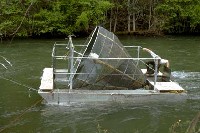 Click on image to enlarge (19K).
Click on image to enlarge (19K).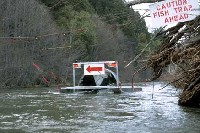 Click on image to enlarge (22K).
Click on image to enlarge (22K).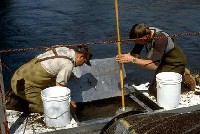 Click on image to enlarge (20K).
Click on image to enlarge (20K). Click on image to enlarge (14K).
Click on image to enlarge (14K). Click on image to enlarge (9K).
Click on image to enlarge (9K).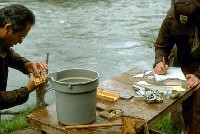 Click on image to enlarge (18K).
Click on image to enlarge (18K).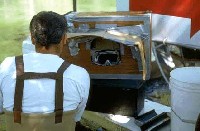 Click on image to enlarge (16K).
Click on image to enlarge (16K).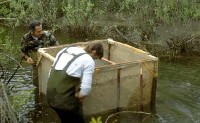 Click on image to enlarge (15K).
Click on image to enlarge (15K).
To learn more about this topic click Info Links
To view additional information (data source, aquisition date etc.) about this page, click Metadata
| www.krisweb.com |
